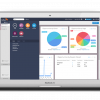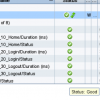Automation
Articles
 |
5 Things That Will Impact the Future of Software Testing From the way we look at software, evaluate risks, think about complexity, design our test approach and strategy, and help to release a stable product to the customer, technology has had an influence on how we test software. And that influence will only continue as technology advances. On a high level, here are five key things we’re already seeing that are going to shape the future of software testing. |
|
 |
Lessons Learned in Testing CRM Software CRM systems manage a company’s business relationships, including customers’ data, information, and interactions, so there’s a lot that can—and should—be tested. Viktar Sachuk talks about his experience in testing CRMs to provide some tips for dealing with the trickiest parts of CRM testing, specifically focusing on some preparatory measures, functional testing, integration testing, and test automation. |
|
 |
For Sustainable Test Automation, Look beyond the Surface When it comes to achieving sustainable test automation, having an appropriate test automation team structure in place is the most important first step to take. This article has some proven practices for a few different test automation adoption scenarios—led by an automation team or a regression team, and with agile adaptations—that have helped organizations enjoy long-term test automation success. |
|
 |
Solving Production Issues Using Testing Tools Standard web-monitoring tools can ping webpages and verify that they’re responding, but they don’t alert you to an issue. But you can use the technology in load testing to monitor your sites by running an interactive script that can detect issues and generate emails as needed. It runs constantly like a silent sentry, never sleeping or taking a vacation, improving your sites' reliability. |
|
 |
The Who, What, When, and How of Pair Testing Pair testing can help you speed up your test assignment and provide more quality to your test results. But who can do pair testing, and when should they do it? And what kind of pair testing is best for your situation? This article gives you more information about how you should conduct pair testing in order to maximize its benefits. |
|
 |
Designing Test Scenarios for Social Media Mobile Apps The definitive features of a mobile social app are the ability to send and receive messages, push notifications, and sharing media such as photos, audio, and videos. While creating a test strategy for such apps, cross-platform compatibility is an important consideration. Here are some scenarios you should include in your test strategy for a social media mobile app. |
|
 |
A Case for Test-First Development You may feel you don't have time to write unit tests, but you really don't have time not to. Steve Poling makes the case that writing tests first not only will yield better code, but will help you get that code working right sooner. Here's how using a test-first approach changes your thinking about coding, lets you see mistakes immediately, and helps you create more testable code. |
|
 |
Uncovering Hidden Boundary Values in Testing Boundary value analysis is a stable of test design, but sometimes the boundaries are not so obvious to the black-box tester. These are called hidden boundaries. This article provides several examples of hidden boundaries, along with some tips to design your test plan in order to reveal hidden boundaries. |
|
 |
Understanding Accessibility Testing: Think like a Dweller, Not a Builder Digital accessibility aims to make any software usable by the widest possible audience. Assistive technology tools, such as screen readers, can help testers model interactions of users with special needs. But testing software design and implementation requires particular test techniques and a certain mindset: You need to think not like the builder of a house, but like the person who will make it their home. |
|
 |
Designing a Valuable Stress Test If you're in a line of e-commerce that sometimes experiences site-crashing levels of volume, executing periodic stress tests is part of a good business plan. Nels Hoenig works for an electric company, so for his site, the main source of stress is power outages. Here, he details his search for a stress-testing tool, what he learned from the tests, and how he convinced others of the value of these tests. |
Pages
Recommended Web Seminars
| May 23 | How Generative AI Boosts Speed and Quality in Software Testing |
| On Demand | Building Confidence in Your Automation |
| On Demand | Leveraging Open Source Tools for DevSecOps |
| On Demand | Five Reasons Why Agile Isn't Working |
| On Demand | Building a Stellar Team |











